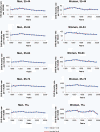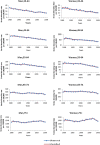Decreasing trends in cardiovascular mortality in Turkey between 1988 and 2008
- PMID: 24079269
- PMCID: PMC3850640
- DOI: 10.1186/1471-2458-13-896
Decreasing trends in cardiovascular mortality in Turkey between 1988 and 2008
Abstract
Background: Cardiovascular disease (CVD) mortality increased in developed countries until the 1970s then started to decline. Turkey is about to complete its demographic transition, which may also influence mortality trends. This study evaluated trends in coronary heart disease (CHD) and stroke mortality between 1988 and 2008.
Methods: The number of deaths by cause (ICD-8), age and sex were obtained from the Turkish Statistical Institute (TurkStat) annually between 1988 and 2008. Population statistics were based on census data (1990 and 2000) and Turkstat projections. European population standardised mortality rates for CHD and stroke were calculated for men and women over 35 years old. Joinpoint Regression was used to identify the points at which a statistically significant (p < 0.05) change of the trend occurred.
Results: The CHD mortality rate increased by 2.9% in men and 2.0% in women annually from 1988 to 1994, then started to decline. The annual rate of decline for men was 1.7% between 1994-2008, whilst in women it was 2.8% between 1994-2000 and 6.7% between 2005-2008 (p < 0.05 for all periods).Stroke mortality declined between 1990-1994 (annual fall of 3.8% in both sexes), followed by a slight increase between 1994-2004 (0.6% in men, 1.1% in women), then a further decline until 2008 (annual reduction of 4.4% in men, 7.9% in women) (p < 0.05 for all periods).
Conclusions: A decrease in CVD mortality was observed from 1995 onwards in Turkey. The causes need to be explored in detail to inform future policy priorities in noncommunicable disease control.
Figures



References
-
- WHO. Global status report on noncommunicable diseases 2010. Geneva: WHO Press; 2011. http://whqlibdoc.who.int/publications/2011/9789240686458_eng.pdf.
-
- WHO. The global burden of disease: 2004 update. Geneva: WHO Press; 2008. http://www.who.int/healthinfo/global_burden_disease/GBD_report_2004updat....
-
- Committee on Preventing the Global Epidemic of Cardiovascular Disease. Meeting the challenges in developing countries, board on global health: promoting cardiovascular health in the developing world a critical challenge to achieve global health. Washington DC: The National Academies Press; 2010. - PubMed
-
- Koc I, Eryurt MA, Adalli T, Seckiner P. Türkiye’nin demografik dönüşümü Doğurganlık, Aile Planlaması, Anne-Çocuk Sağlığı ve Beş Yaş Altı Ölümlerdeki Değişimler: 1968–2008. Ankara: Hacettepe Üniversitesi Nüfus Etütleri Enstitüsü; 2010. http://www.hips.hacettepe.edu.tr/TurkiyeninDemografikDonusumu_220410.pdf.
-
- World Bank. Turkey Overview. http://www.worldbank.org/en/country/turkey/overview.
Publication types
MeSH terms
LinkOut - more resources
Full Text Sources
Other Literature Sources
Medical

